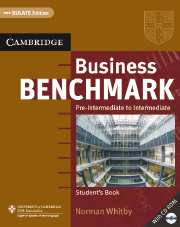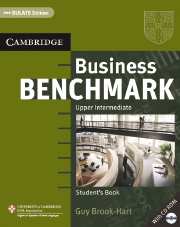
June 2006
Volume 10, Number 1
| Contents | | | TESL-EJ Top |
 |
June 2006
|
||
|
Business Benchmark Pre-Intermediate to Intermediate | |||
| Author: | Whitby, N. (2006) |  | |
| Publisher: | Cambridge: Cambridge University Press | ||
| Pages | ISBN | Price | |
|---|---|---|---|
| Pp.183 | ISBN-0-521-67117-5 (paper) | £15.00 | |
Business Benchmark Upper Intermediate | |||
| Author: | Brook-Hart, G. (2006) |  | |
| Publisher: | Cambridge: Cambridge University Press | ||
| Pages | ISBN | Price | |
|---|---|---|---|
| Pp.184 | ISBN-0-521-67289-9 (paper) | £20.00 | |
On the CUP website (http://www.cambridge.org) Whitby's and Brook-Hart's books are introduced thus: "Business Benchmark is a brand new 3 level Business English course for BEC or BULATS exams and can also be used independently of these exams for general Business English courses." The first thing I find interesting about this description is the use of the "and" when which or that would seem the more obvious choice. I have to admit, I re-read the original sentence repeatedly asking myself, is the "and" a deliberate marketing ploy to make the course sound like it has something extra to offer the teacher and student, or was it just a simple error? Either way, having a somewhat unnatural sounding sentence as the first sentence describing a new English Language course book is perhaps not the best advertisement.
Language usage aside, according to the website descriptions of Business Benchmark, there are two levels of course book available: (1) pre-intermediate to intermediate level and (2) upper intermediate level. What is unusual about Business Benchmark is that there are two versions of the Student's Book for each level, one aimed specifically at the BEC Exams (Cambridge ESOL Business English Certificate Exams) and the other for the BULATS Exam (Cambridge ESOL Business Language Testing Service). Each version of the Student's Book has its own accompanying audio cassette/CD. However, despite the fact that there are separate Student's Books designed for the BEC and BULATS exams respectively, there is only one Teacher's Resource Book per level, which, according to the publishers, can be used in conjunction with either the BEC or BULATS versions of the Student's Book--or both. And finally, it is curious to note that there seems to be only one level of the Student Personal Study Book (a pocket-sized workbook) available at present, the pre-intermediate to intermediate level, again meant to be suitable to accompany either or both Student's Books. Would one presume that an upper-intermediate Personal Study Book would follow?
As you have probably already gathered, Business Benchmark is an ambitious attempt to meet the needs of students preparing for the Cambridge Business English Exams, whether BEC or BULATS. Obviously, the choice of course book for students studying specifically for one exam is clear cut, for example, an intermediate level student preparing for the BULATS exam would logically chose the pre-intermediate to intermediate Level BULATS Benchmark textbook. But what about teachers like myself, preparing undergraduate business students for using English in their future working lives: which course book should we choose, BEC or BULATS? How can we really know which exam will be most useful to our students in the future? For me, a real innovation would have been a course book that introduced both exams side by side. Also, if the Teacher's Book and Personal Study Book can cover both exams at the same time, why not the Student's Book? As things stand, one possibly effective way to use this course book for general Business English students might be to run a two level course, using the BEC version for one level and the BULATS version for the other level. That way students could see both exam formats and have some variation in the style of textbook as well, since the layout, type of activities and most importantly, the exam preparation and practice activities do vary from one book to the other.
Moving on to the content of the two textbooks under review, it has to be said that they are both undoubtedly excellent exam preparation manuals, offering a variety of stimulating topics and tasks that cover all four skills, vocabulary, grammar, and exam technique and preparation. Both books, in my view, also are particularly strong in lexis and structure building.
However, I am not convinced that using these books in general Business English courses would be so effective. I believe they could be accessible and motivational for working adults/job-experienced adults, but I suspect they may need some supplementing for students who have had no real work experience. Both books do attempt to address pre-work students by suggesting alternative topics/tasks that students with no work experience could do, and there are also supplementary photocopiable activities in the Teacher's Resource Book available. However, if you, like me, have pre-work undergraduate business students, many of whom have not yet really developed a genuine interest in business or in learning functional business language, you might need to supplement the course with more general-interest subjects to keep them motivated.
Some of the things I particularly like about the Benchmark Student's Books are:
Overall, I would highly recommend these two books as preparation manuals for the BEC or BULATS exams, as well as for use in general Business English courses for adults with work experience. However, for those who teach pre-work students, I think the success of these books in the classroom could depend a lot on the level of business interest and motivation of the individual students in question. Therefore, for pre-work students, I would recommend that teachers study the content of the units very carefully to make sure there is enough material of relevant interest to their prospective students, before deciding whether or not to incorporate these textbooks into a course of study.
Business Benchmark: http://www.cambridge.org/elt/elt_projectpage.asp?id=2500130
BEC Exams: http://www.cambridgeesol.org/exams/bec.htm
BULATS Exam: http://www.bulats.org/
Fiona Cromarty-Lawtie
Université Libre de Bruxelles
<Fiona.cromarty ulb.ac.be>
ulb.ac.be>
|
© Copyright rests with authors. Please cite TESL-EJ appropriately.
Editor's Note: The HTML version contains no page numbers. Please use the PDF version of this article for citations. |